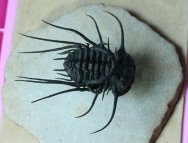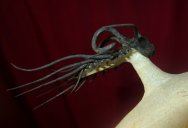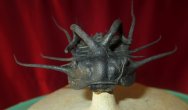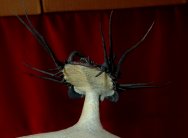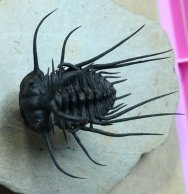Dicranurus monstrosus
Trilobites Order Lichida, Family Odontopleuridae
Geological Time: Middle Devonian
Size (25.4 mm = 1 inch): Trilobite is 80 mm long by 85 mm wide (with spines) on a 130 mm by 120 mm matrix
Fossil Site: Aatchana, Alnif , Morocco
Fossil Code: 12120
Price: Sold
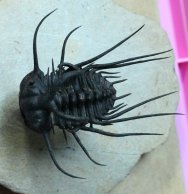 Description:
Here is one of the more sought after trilobites of the Order
Lichida, Family Odontopleuridae known as Dicranurus monstrosus.
This particular example is quite large at 80 mm in length from
the dramatic cephalon to the wonderful pleural spines, and has
a "wingspan" of 85 mm at the genal spines. Notice that
the librigenae are tightly attached, a sign of a well-articulated
specimen. It is found in the Devonian Laatchana Formation deposits
near Alnif, Morocco. It is quite prone, and dominates its bed
of matrix. To me, the most impressive features are the dramatically
retorted occipital spines, looking like ram's horns. ALL spines
have been prepared freestanding on the cephalon as well as those
on pleural lobes, and also the pygidial spines making for a dramatic
display. Note too that the hypostome which served as an anchor
for the mouthparts has also been prepped out. With the advent
of a reliable source of electricity in Morocco, the quality of
preparation has improved dramatically over the past few years.
This one took a great deal of effort to prepare all the pleural
spines free of matrix. While I used to refer to trilobites prepared
in a mode similar to this as flying, I feel a new term is Description:
Here is one of the more sought after trilobites of the Order
Lichida, Family Odontopleuridae known as Dicranurus monstrosus.
This particular example is quite large at 80 mm in length from
the dramatic cephalon to the wonderful pleural spines, and has
a "wingspan" of 85 mm at the genal spines. Notice that
the librigenae are tightly attached, a sign of a well-articulated
specimen. It is found in the Devonian Laatchana Formation deposits
near Alnif, Morocco. It is quite prone, and dominates its bed
of matrix. To me, the most impressive features are the dramatically
retorted occipital spines, looking like ram's horns. ALL spines
have been prepared freestanding on the cephalon as well as those
on pleural lobes, and also the pygidial spines making for a dramatic
display. Note too that the hypostome which served as an anchor
for the mouthparts has also been prepped out. With the advent
of a reliable source of electricity in Morocco, the quality of
preparation has improved dramatically over the past few years.
This one took a great deal of effort to prepare all the pleural
spines free of matrix. While I used to refer to trilobites prepared
in a mode similar to this as flying, I feel a new term is 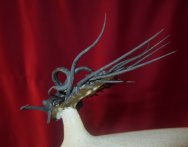 warranted
by the preparation now coming into vogue. This specimen is truly
stunning when viewed from any aspect, and is destined to become
the cornerstone of any collection, public or private. (I apologize
for the less-than-esthetic photography while still in the shipping
container, but discretion was the better part of valor with all
the spines). warranted
by the preparation now coming into vogue. This specimen is truly
stunning when viewed from any aspect, and is destined to become
the cornerstone of any collection, public or private. (I apologize
for the less-than-esthetic photography while still in the shipping
container, but discretion was the better part of valor with all
the spines).
To what purpose could this spiny exoskeleton have been evolved? The answer is simple -- DEFENSE!! Fish had recently evolved jaws, and in the never ending arms race between predator and prey, Dicranurus' amswer was a spectacular defensive array of spines. A substantial amount of prep time goes into a dramatic specimen such as this, with a concomitant high end price. Nevertheless, it is still $100s less than some I have seen for sale for a truly world-class fossil. This is a fine example sure to become a prized member of any collection. See my other listing for a roughly contemporary species Dicranurus hamatus elegantus prepared by Bob Carroll, Oklahoma trilobite preparator nonpareil. |
